Energy Efficient Lighting Market Size:
Energy Efficient Lighting Market Size is estimated to reach over USD 92.11 Billion by 2032 from a value of USD 47.08 Billion in 2024 and is projected to grow by USD 50.23 Billion in 2025, growing at a CAGR of 8.8% from 2025 to 2032.
Energy Efficient Lighting Market Scope & Overview:
Energy efficient lighting refers to using lighting solutions that consume less energy while maintaining the same or better quality of light compared to traditional lighting systems. Energy-efficient lighting technologies, including LED, CFL, and OLED, offer substantial energy savings compared to traditional incandescent and halogen lighting. These technologies not only reduce electricity consumption but also lower greenhouse gas emissions, aligning with global efforts to combat climate change. The adoption of energy efficient lighting is further encouraged by stringent government regulations and policies aimed at promoting energy efficiency and reducing carbon footprints.
How is AI Transforming the Energy Efficient Lighting Market?
AI is being used to improve the energy efficiency of lighting systems. AI-powered smart lighting systems can analyze data from sensors, such as occupancy and daylight sensors, to optimize lighting based on real-time conditions, which leads to reduced energy consumption, lower costs, and increased energy efficiency. Further, AI-powered lighting systems can also learn user preferences and adjust lighting accordingly, thereby creating customized lighting scenes and schedules. Therefore, the aforementioned factors are expected to positively impact the market growth in upcoming years.
Energy Efficient Lighting Market Dynamics - (DRO) :
Key Drivers:
Growing adoption of environmental sustainability solutions is driving the energy efficient lighting market expansion
Environmental sustainability refers to the responsible use of resources to maintain ecological balance and ensure the well-being of current and future generations. Sustainability plays a crucial role in mitigating environmental impacts associated with energy consumption and lighting infrastructure. Energy-efficient technologies such as LEDs contribute significantly to environmental sustainability by reducing energy consumption. LEDs consume much less electricity than traditional incandescent and fluorescent bulbs, leading to lower greenhouse gas emissions from power plants. The longevity of energy-efficient lighting solutions contributes to environmental sustainability by reducing waste.
- For instance, in January 2025, Energy Efficiency Services Limited has successfully deployed 13.4 million LED streetlights across Urban Loca Bodies (ULB) and Gram Panchayats, to save 9,001 million units annually. This project will create the demand by more than 1,500 MW and decrease in CO2 emissions by 6.2 million per year.
Thus, according to the energy efficient lighting market analysis, the growing adoption of environmental sustainability solutions is driving the energy efficient lighting market size and trends.
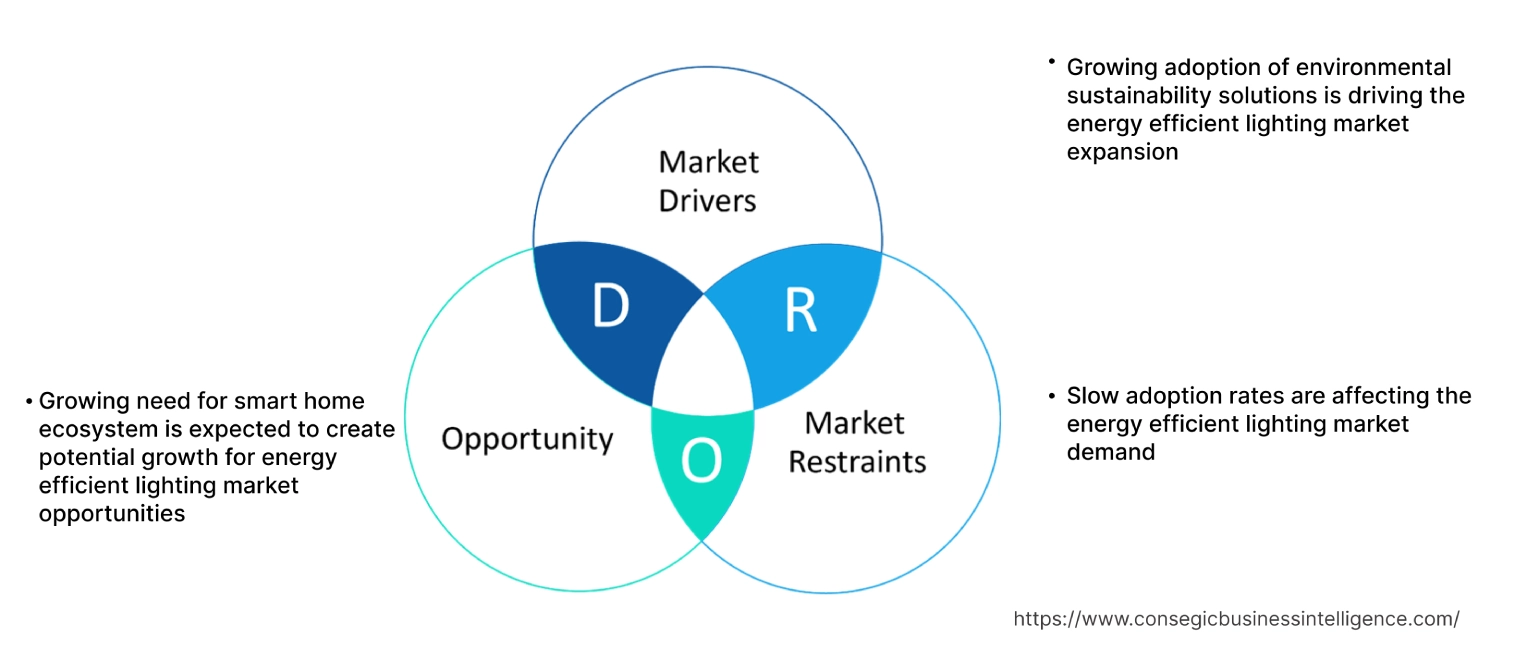
Key Restraints:
Slow adoption rates are affecting the energy efficient lighting market demand
High upfront costs can deter consumers and businesses, particularly in regions with lower economic stability or where immediate cost savings are prioritized over long-term benefits. There is often a lack of awareness or understanding about the advantages of energy efficient lighting, leading to hesitation in replacing traditional lighting systems. Further, compatibility issues with existing fixtures and the perceived complexity of integrating new technologies can also slow down adoption. Therefore, the aforementioned factors would further impact the energy efficient lighting market.
Future Opportunities :
Growing need for smart home ecosystem is expected to create potential growth for energy efficient lighting market opportunities
The development of smart home ecosystem presents a significant prospect for the global market. Smart home ecosystems encompass interconnected devices and systems within a household that communicate and operate seamlessly to enhance convenience, security, and energy efficiency. Smart lighting plays a pivotal role within these ecosystems by offering integration with other smart devices such as voice assistants, sensors, and home automation systems.
Further, as smart home adoption grows, fueled by increasing consumer demand for connected living experiences, the demand for smart lighting solutions is expected to rise. Manufacturers are developing interoperable platforms that enable different smart devices to communicate and collaborate effectively. This interoperability allows users to control their lighting alongside other smart appliances and systems through a single interface, enhancing user convenience and usability.
- For instance, in August 2022, Hafele America Co. launched the Loox illuminated adjustable shelf system. The system was designed for entertainment centers, closets, pantries, and kitchens. The system has adjustable shelves and wireless controllers, with a variety of lighting options, to mee the consumer needs. This development is expected to strengthen company’s growth and energy efficient lighting market share in the global market.
Thus, based on the above energy efficient lighting market analysis, the above factors are expected to drive the energy efficient lighting market opportunities and trends.
Energy Efficient Lighting Market Segmental Analysis :
By Type:
Based on type, the energy efficient lighting market is segmented into incandescent lamp, light emitting diode (LED), arc lamp, and gas discharge lamps.
Trends in the type:
- Consumers can easily browse through various brands and types of energy-efficient lamps, compare prices, read reviews, and make purchases from the comfort of their homes. The growth of online retail platforms, such as Amazon, eBay, and various region-specific e-commerce websites, has made it more convenient for consumers to access energy-efficient lighting solutions.
- Governments worldwide are implementing regulations to phase out inefficient lighting solutions and promote the adoption of energy-efficient alternatives such as LEDs (light-emitting diodes) and CFLs (compact fluorescent lamps). These measures are aimed at reducing energy consumption, lowering carbon emissions, and mitigating climate change impacts.
- Thus, the above analysis and factors are driving the energy efficient lighting market demand and trends.
The incandescent lamp segment accounted for the largest revenue share in the year 2024.
- Incandescent lamps are relevant in automotive industry, where they are utilized in dashboard lights and indicator signals, contributing to their presence in multiple applications.
- Incandescent lamps have become a popular choice for decorative purposes, particularly in residential and commercial settings. The increasing emphasis on interior design and aesthetics is significantly driving the segment development.
- Thus, based on the above analysis, these factors are further driving the energy efficient lighting market growth and trends.
The light emitting diode (LED) segment is anticipated to register the fastest CAGR during the forecast period.
- LEDs consume significantly less energy to produce the same amount of light as conventional lighting sources, resulting in reduced electricity bills and lower carbon emissions.
- Governments and organizations globally are incentivizing the adoption of LEDs through energy efficiency regulations, subsidies, and green building certifications, driving market expansion across residential, commercial, industrial, and outdoor lighting industry.
- Innovations in LED chip design, packaging techniques, and phosphor materials have enhanced efficiency, color rendering capabilities, and reliability of LEDs. This continuous innovation allows LEDs to penetrate new applications such as automotive lighting, horticultural lighting, and digital displays, expanding their market reach and creating opportunities for manufacturers and suppliers.
- For instance, in May 2023, Dialight launched the ProSite High Mast, a floodlight series of ProSite. This is a sophisticated LED lighting fixture specifically designed for high-mounting applications, reaching up to 130 feet. It is intended for a variety of outdoor industrial settings such as airports, rail yards, container yards, transportation hubs, parking areas, storage piles of materials, and for securing property perimeters.
- Thus, based on the above analysis, these developments are expected to drive the energy efficient lighting market share and trends during the forecast period.
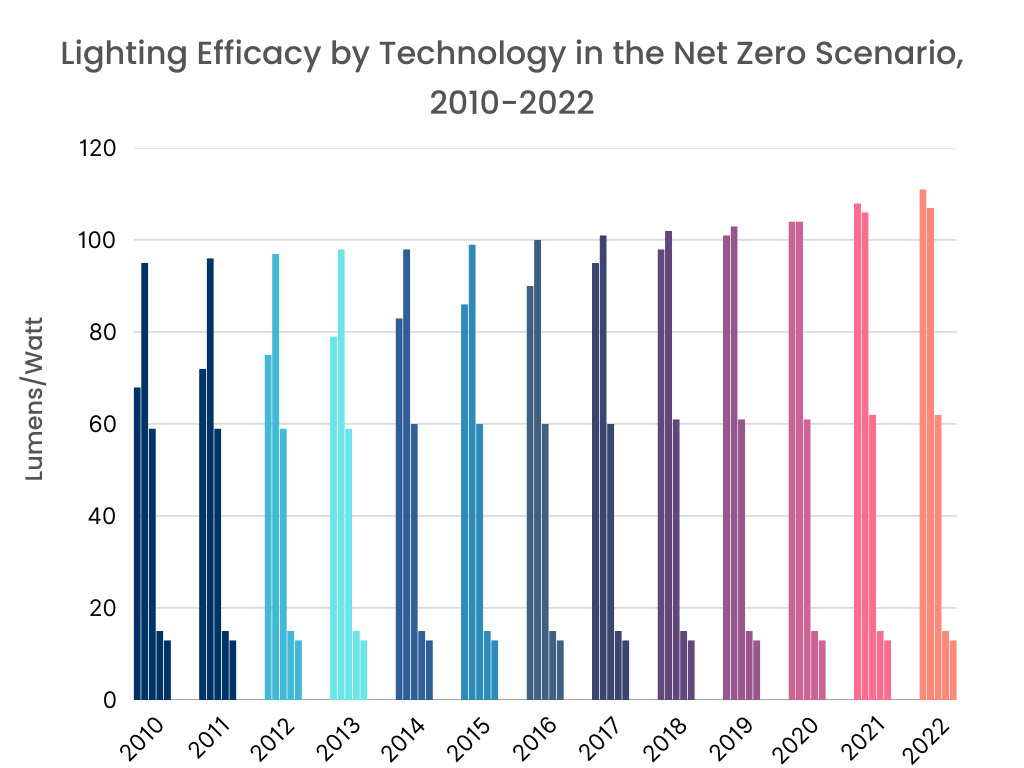
By Application:
Based on application, the energy efficient lighting market is segmented into residential, commercial, and industrial.
Trends in the application:
- The increasing demand for energy-saving solutions, coupled with government initiatives promoting smart buildings, is driving the growth of energy efficient lighting market in various applications.
- Smart street lighting plays a crucial role in smart city initiatives, where cities worldwide are deploying connected lighting networks to reduce electricity costs and enhance urban security. The integration of AI and cloud-based management systems further enhances the efficiency and functionality of outdoor smart lighting solutions.
- These analysis and factors are anticipated to further drive the energy efficient lighting market trends during the forecast period.
The commercial segment accounted for the largest revenue share of 43.51% in the year 2024.
- Commercial applications encompass a wide range of settings including office buildings, retail stores, hotels, restaurants, and other business establishments.
- Energy-efficient lighting solutions are highly favoured in commercial spaces due to their ability to reduce operating costs over time.
- LED lighting is widely adopted in commercial applications due to its energy efficiency, long lifespan, and lower maintenance requirements.
- Moreover, in commercial settings, lighting plays a crucial role in creating an inviting atmosphere for customers, enhancing product visibility, and improving overall employee productivity and well-being.
- For instance, in March 2023, Itron Inc. announced the collaboration with Duquesene Light Company (DLC) to modernize their operations and infrastructure, paving the way for smart city technologies. As part of this agreement, Itron will provide DLC with its intelligent street lighting system. This system includes energy-efficient LED lights equipped with sensors and software that will allow DLC to remotely adjust lighting levels, gather data, and manage traffic flow. The implementation of this solution is anticipated to help DLC save energy, enhance public safety, and gain deeper insights into their customers' energy usage patterns.
- These developments and analysis in the commercial segment are driving the energy efficient lighting market growth and trends.
The residential segment is anticipated to register the fastest CAGR during the forecast period.
- In residential settings, energy-efficient lighting technologies are increasingly popular among homeowners seeking to reduce energy consumption and lower electricity bills.
- LED lighting has become the preferred choice for residential lighting due to its energy efficiency, versatility in design, and long lifespan.
- LEDs not only provide cost savings but also contribute to creating a comfortable and aesthetically pleasing living environment.
- Residential applications of energy-efficient lighting include indoor lighting (such as kitchen, living room, and bedroom lighting) as well as outdoor lighting (such as garden lights, pathway lights, and security lighting).
- For instance, Falcon Group offers smart bulbs (LEDs) that are more energy efficient and uses less electricity in homes to produce light. They have longer lifespan and reduce the frequency of replacements and the associated waste.
- Thus, above factors are expected to drive the energy efficient lighting market trends during the forecast period.
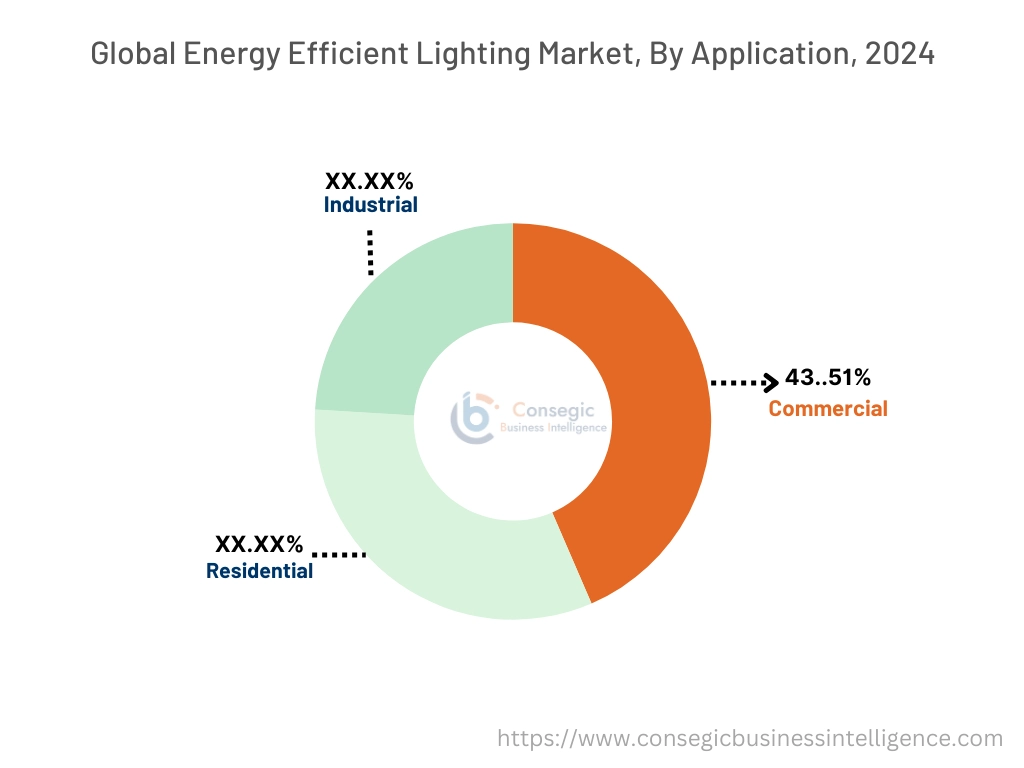
Regional Analysis:
The regions covered are North America, Europe, Asia Pacific, the Middle East and Africa, and Latin America.
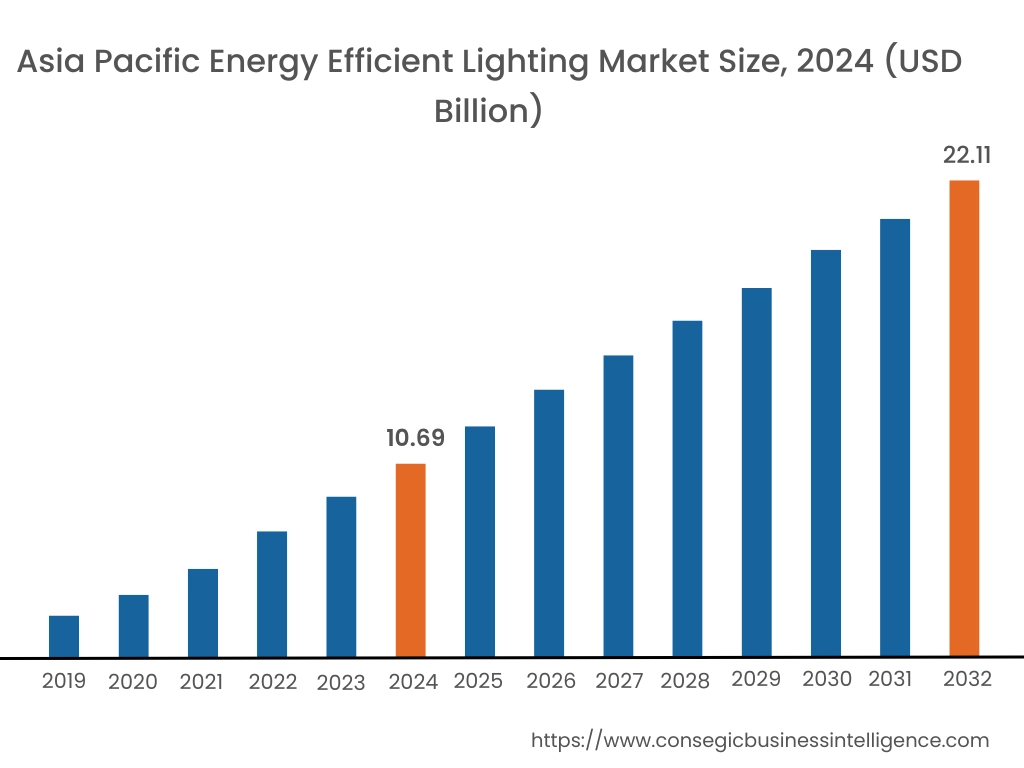
Asia Pacific energy efficient lighting market expansion is estimated to reach over USD 22.11 billion by 2032 from a value of USD 10.69 billion in 2024 and is projected to grow by USD 11.46 billion in 2025. Out of this, the China market accounted for the maximum revenue split of 30.13%. Asia Pacific represents a rapidly growing market for energy-efficient lighting technologies, fueled by urbanization, infrastructure development, and increasing awareness of energy conservation. Countries in the region are major contributors to market growth, driven by government initiatives to reduce energy consumption and carbon emissions. LED lighting dominates the region due to its cost-effectiveness and suitability for diverse applications ranging from residential buildings to large-scale industrial complexes. Further, the regional market is competitive with a mix of local and global players expanding their product offerings and manufacturing capabilities. These factors would further drive the regional energy efficient lighting market during the forecast period.
- For instance, in October 2023 Halonix Technologies released a new LED bulb called UP-DOWN GLOW, in India, which offers three different lighting modes controlled by a switch. This innovative bulb features a dome, an upper section, and a stem (the lower part), all of which illuminate in various colors to provide a more engaging experience for users.
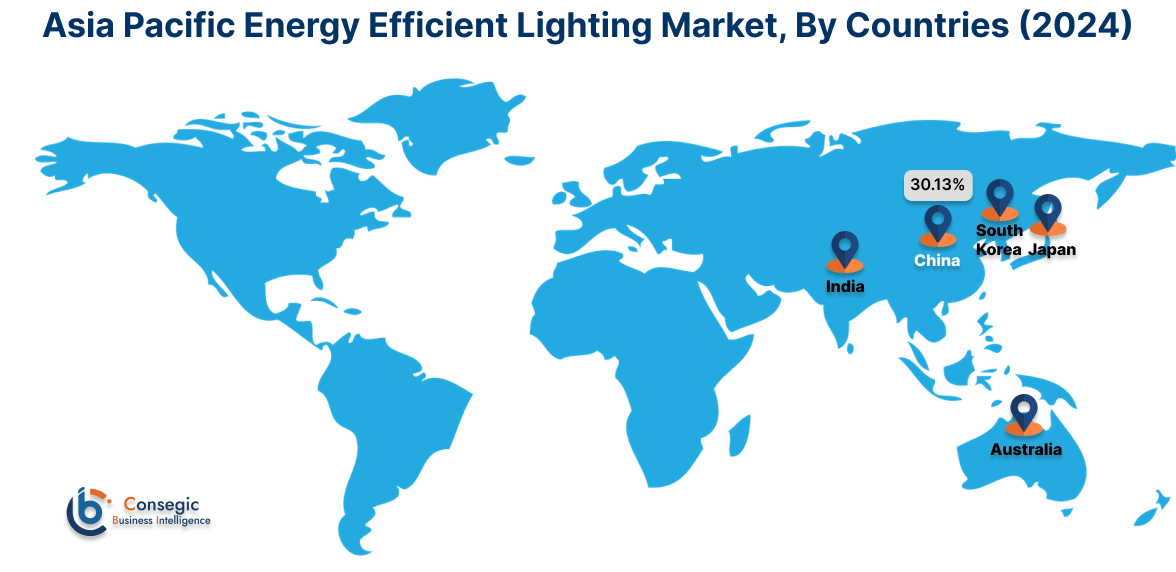
North America market is estimated to reach over USD 32.55 billion by 2032 from a value of USD 16.72 billion in 2024 and is projected to grow by USD 17.84 billion in 2025. North American market for energy-efficient lighting technologies is driven by stringent energy efficiency regulations, government incentives, and a strong emphasis on sustainability. Further, the commercial sector, including offices, retail spaces, and hospitality, in the region are significant adopters of smart lighting solutions. Additionally, residential adoption is growing as consumers seek to reduce energy costs and environmental impact. Moreover, key players in this region focus on technological advancements and smart lighting solutions to cater to diverse customer needs. These factors would further drive the regional market share during the forecast period.
- For instance, in January 2024, Legrand announced the latest offering of smart lighting solutions in Consumer Electronics Show, Las Vegas. The smart lighting solutions are Wi-Fi enabled, which can be controlled from Matter Controllers (Alexa). It makes it easier to control lights and appliances, with more advanced automations, while reducing the energy costs.
Additionally, according to the analysis, the energy efficient lighting industry in Europe is expected to witness significant development during the forecast period. Europe is a leading market for lighting technologies, characterized by comprehensive regulations promoting energy efficiency and carbon reduction targets. The transition from traditional lighting technologies to LEDs is well-established across residential, commercial, and industrial sectors.
Additionally, Latin America is a growing market for energy-efficient lighting technologies, driven by rising energy costs, environmental concerns, and government policies promoting energy efficiency. Further, in the Middle East and Africa, LED lighting is gaining traction in urban development projects, commercial buildings, and public infrastructure due to its energy-saving benefits and long-term cost-effectiveness. Government-led programs and investments in smart city projects further drive the market growth, particularly in urban centers and emerging economies. These factors are driving the regional energy efficient lighting market size and share.
Top Key Players and Market Share Insights:
The global energy efficient lighting market is highly competitive with major players providing products to the national and international markets. Key players are adopting several strategies in research and development (R&D), product innovation, and end-user launches to hold a strong position in the market. Key players in the energy efficient lighting industry include-
- ABB (Switzerland)
- Acuity Brands (U.S.)
- Advanced Lighting Technologies Australia Inc. (Australia)
- Bajaj Electricals Ltd. (India)
- Bridgelux (U.S.)
- Cooper Lighting (U.S.)
- Dialight (U.K.)
- Digital Lumens, Inc. (U.S.)
- Eaton (Ireland)
- General Electric Company (U.S.)
- LIGMAN Lighting Co., Ltd. (Thailand)
- OSRAM GmbH (Germany)
- Philips Lighting Holding B.V. (Netherlands)
- Schneider Electric (France)
- The Lighting Quotient (U.S.)
- Toshiba Lighting & Technology Corporation (Japan)
Energy Efficient Lighting Market Ecosystem:
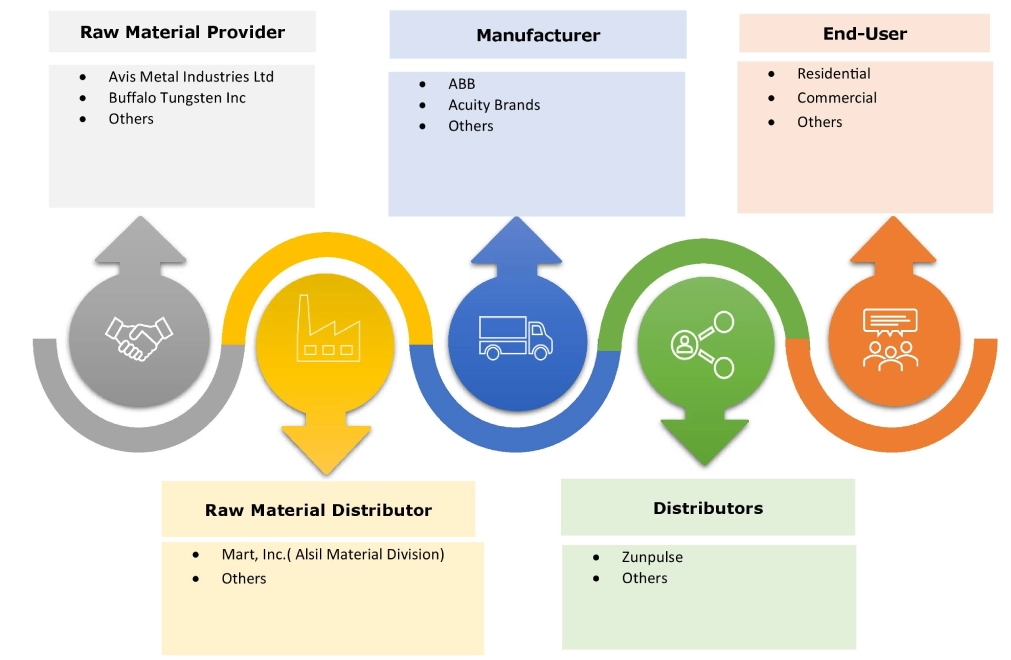
Recent Industry Developments :
Collaborations and Partnerships:
- In December 2024, Energy Efficiency Services (EESL) announced a partnership with Padma Vadhya, to expand the reach of energy efficient lighting solutions in Telangana state, India. By creating retail franchises that make energy-efficient technologies more readily available, this partnership intends to support India's climate objectives through energy conservation and the reduction of carbon emissions.
Energy Efficient Lighting Market Report Insights :
| Report Attributes | Report Details |
| Study Timeline | 2019-2032 |
| Market Size in 2032 | USD 92.11 Billion |
| CAGR (2025-2032) | 8.8% |
| By Type |
|
| By Application |
|
| By Region |
|
| Key Players |
|
| North America | U.S. Canada Mexico |
| Europe | U.K. Germany France Spain Italy Russia Benelux Rest of Europe |
| APAC | China South Korea Japan India Australia ASEAN Rest of Asia-Pacific |
| Middle East and Africa | GCC Turkey South Africa Rest of MEA |
| LATAM | Brazil Argentina Chile Rest of LATAM |
| Report Coverage |
|
Key Questions Answered in the Report
How big is the Energy Efficient Lighting Market? +
Energy Efficient Lighting market size is estimated to reach over USD 92.11 Billion by 2032 from a value of USD 47.08 billion in 2024 and is projected to grow by USD 50.23 Billion in 2025, growing at a CAGR of 8.8% from 2025 to 2032.
Which is the fastest-growing region in the Energy Efficient Lighting Market? +
Asia-Pacific is the region experiencing the most rapid growth in the market.
What specific segmentation details are covered in the Energy Efficient Lighting report? +
The energy efficient lighting report includes specific segmentation details for type, application, and region.
Who are the major players in the Energy Efficient Lighting Market? +
The key participants in the market are ABB (Switzerland), Acuity Brands (U.S.), Advanced Lighting Technologies Australia Inc. (Australia), Bajaj Electricals Ltd. (India), Bridgelux (U.S.), Cooper Lighting (U.S.), Dialight (U.K.), Digital Lumens, Inc. (U.S.), Eaton (Ireland), General Electric Company (U.S.), LIGMAN Lighting Co., Ltd. (Thailand), OSRAM GmbH (Germany), Philips Lighting Holding B.V. (Netherlands), Schneider Electric (France), The Lighting Quotient (U.S.), Toshiba Lighting & Technology Corporation (Japan), and others.

